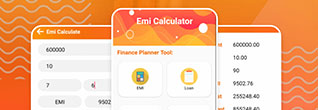

When people take a loan, especially for buying a house or property under construction, they usually have two types of EMI payment options – Pre-EMI and Full-EMI. These options affect how much interest you pay and how the loan is set up. Choosing the right one can help manage your finances better.
Many people get confused between these two options, so let’s explain them in the simplest way.
Pre-EMI is a type of loan repayment where you only pay the interest on the loan amount that has been disbursed. You do not start repaying the principal amount immediately.
For example, if you take a home loan for an under-construction property, the bank or lender does not give the entire loan amount at once. Instead, it is given in parts to the builder as construction progresses. During this period, you only pay the interest on the amount that has been given out. This is called Pre-EMI.
Pre-EMI continues until the full loan amount is disbursed. Once the entire loan is given to the builder, regular EMI payments begin, which include both principal and interest.
Full-EMI means you start paying both principal and interest from the very first EMI itself, regardless of whether the loan amount has been fully disbursed or not.
Even if the builder has not received the full loan amount, the borrower pays a fixed EMI that includes interest and principal. This means the loan repayment begins immediately, and the outstanding loan amount starts reducing from the beginning.
Pre-EMI: Only interest is paid during the initial period.
Full-EMI: Both principal and interest are paid from the first EMI.
Pre-EMI: The loan tenure remains longer since principal repayment starts later.
Full-EMI: The loan tenure remains the same, but repayment starts early.
Pre-EMI: Since principal repayment is delayed, the total interest paid over the years is higher.
Full-EMI: Interest is lower since repayment starts early, reducing the outstanding loan amount faster.
Pre-EMI: Monthly payments are lower in the beginning, making it easier to manage other expenses.
Full-EMI: The EMI amount is higher from the start, which can be difficult for some borrowers.
Pre-EMI: Suitable for those who have a tight budget and cannot afford full EMI immediately.
Full-EMI: Suitable for those who can afford full EMI early and want to reduce overall loan interest.
Pre-EMI: Tax benefits on home loans under Section 80C and Section 24(b) start only after possession of the property.
Full-EMI: Tax benefits can be claimed immediately if the property is ready for possession.
Pre-EMI: The borrower does not repay the principal initially, which means if the builder delays possession, the borrower ends up paying only interest for a longer period.
Full-EMI: Since principal repayment starts early, the loan reduces faster even if the builder delays possession.
Pre-EMI: Can lead to a higher financial burden later since the actual repayment starts only after possession.
Full-EMI: Helps in completing the loan faster and paying less interest in the long run.
Choosing between Pre-EMI and Full-EMI depends on your financial situation and goals.
If you're buying a house that's still under construction and want lower monthly payments at first, Pre-EMI might be a good choice.
If you can afford to start paying the full EMI from the beginning, it’s better to go with Full-EMI because it reduces the overall loan cost.
If there’s a chance of delay in getting the property, Full-EMI is a better option because it avoids stretching out the loan repayment unnecessarily.
Pre-EMI and Full-EMI are two ways to repay a loan, and each has its pros and cons. Pre-EMI lowers your payments at first but results in paying more interest over time. Full-EMI means higher payments from the start, but it helps pay off the loan faster and reduces overall interest. It’s important to consider your financial situation, tax benefits, and any risks before deciding. Talking to a financial advisor or carefully reading the loan agreement can help you choose the best option.
We understand that getting a loan can be very stressful with confusing documents, unclear communication, and various other challenges. That is why we take care of your loan application process, saving you time and hassle by handling the paperwork and communicating with the loan providers.
Check the details here at EazyBankLoan
Need help? Reach out at support@eazybankloan.com
Yes, some banks allow borrowers to switch from Pre-EMI to Full-EMI once the loan is fully disbursed.
Pre-EMI is mostly available for home loans, especially for under-construction properties. It is not commonly used for personal or car loans.
If possession is delayed, you will keep paying only the interest, which increases the total interest paid on the loan.
Yes, since you start repaying the principal early, the loan gets paid off sooner compared to Pre-EMI.
Yes, you can make prepayments, but it is better to check with the lender if there are any prepayment charges.
No List Founds!
Your email address will not be published. Required fields are marked *
